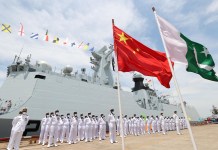India’s induction of additional Rafale fighter jets has prompted its arch-rival China to fast-track the process of modifying its ‘most advanced’ Chengdu J-20 stealth fighters, according to reports.
Indian Army, Chinese PLA Troops Start Disengagement Process From Contested Ladakh Border
Last month, India had received the third batch of French-made ‘Omni-role’ Rafale fighter jets. Three aircraft had landed in the country after flying non-stop from France.
India will have 17 Rafale jets by March this year, Defense Minister Rajnath Singh said in Parliament on February 8. He also assured that the country will get the entire fleet of 36 Rafales by April 2022.
After engaging in a nine-month-long border standoff, India and China have finally started disengaging their troops from a contested region in Ladakh.
Despite such moves, China has focused on the combat readiness of its troops and upgrading the J-20 stealth jets.
According to India’s Times Now, Beijing is really concerned by the attacking prowess of the Rafales, and as a result, is looking to upgrade its homegrown J-20 fighters.
Designed and manufactured by the French company Dassault, Rafales have been an important tool for France to compete with the American F-16 sales worldwide.
It is a canard delta wing, twin-engine, multirole fighter jet, which can perform air supremacy, interdiction, aerial reconnaissance, ground support, in-depth strike, anti-ship strike, and nuclear deterrence missions.
Why China Wants To Upgrade J-20
Over the recent years, the Chinese have proved their mettle in developing advanced aircraft, including the state-of-the-art J-20s. However, one area which proves to be Achilles’ heel for Beijing is the production of advanced engines to power the ‘most advanced’ J-20 fighters.
The country is looking to replace the Russian engine of the J-20 with a more advanced locally-made version. According to reports, the J-20 twin-seater, a trainer currently possessing the WS-10 engine, could be powered by a more powerful WS-15 engine in the future.

There are also reports suggesting China could be looking to modify the J-20s to turn them into carrier-based fighters. It seems plans are afoot to enable the J-20s to land and take-off from the Chinese aircraft carriers — the Liaoning and the Shandong.
In November last year, the communist country had carried out a high-profile exercise involving its J-20 fighters in the Gobi desert in northern China. Six to eight J-20s were believed to have been used in the war drill which involved live firing, the Times Now report said.
The exercise was preceded by a series of drills or military simulations in which the performances of the fighters were tested under all parameters. All types of military hardware including aircraft, missiles, tanks, utility vehicles, and defense systems have to go through such drills to prove that their efficiency is intact.
In military simulations, theories of warfare are tested to develop tactical and strategic solutions, aimed at achieving superiority in actual combat.
For combat aircraft, flight simulators are used. A simulator is a device used to re-create a fighter jet and realistic physical aspects of the actual aircraft cockpit, often with a full-motion platform.
It is used for training pilots and to research the fighter jets’ characteristics and control handling qualities.
The exercise was carried out at China’s Dingxin Test and Training Base, a sprawling facility located in the Gansu Province in the Gobi Desert.
The area has long been a military and weapons testing stronghold for the Chinese PLA, with the base being one of the most unique in the country.
It supports the development of tactics and weaponry as well as advanced training of PLA Air Force (PLAAF) units in high-end, complex scenarios, with live-fire drills.
Follow EurAsian Times on Google News




